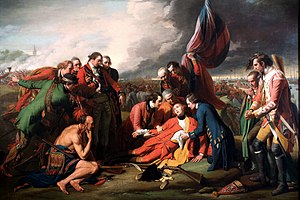|
Benjamin West |

Self Portrait of Benjamin West, ca. 1763 |
| Born |
October 10, 1738(1738-10-10)
Springfield, Pennsylvania |
| Died |
March 11, 1820 (aged 81)
London |
| Field |
historical painting |
| Patrons |
William Henry
King George III |
Benjamin West RA (October 10, 1738 – March 11, 1820) was an Anglo-American
painter of historical scenes around and after the time of the American War of
Independence. He was the second president of the Royal Academy serving from
1792 to 1805 and 1806 to 1820.
Early life
He was born in Springfield, Pennsylvania, in a house that is now in the
borough of Swarthmore on the campus of Swarthmore College,[1] as the tenth
child of an innkeeper. The family later moved to Newtown Square, Pennsylvania,
where his father was the proprietor of the Square Tavern, still standing in
that town. West told John Galt, with whom, late in his life, he collaborated
on a memoir, The Life and Studies of Benjamin West (1816, 1820) that, when he
was a child, Native Americans showed him how to make paint by mixing some clay
from the river bank with bear grease in a pot. Benjamin West was an
autodidact; while excelling at the arts, "he had little [formal] education
and, even when president of the Royal Academy, could scarcely spell"(Hughes,
70).
From 1746 to 1759, West worked in Pennsylvania, mostly painting portraits.
While in Lancaster, Pennsylvania, in 1756, West's patron, a gunsmith named
William Henry, encouraged him to design a "Death of Socrates" based on an
engraving in Charles Rollin's Ancient History; the resulting composition,
which significantly differs from West's source, has been called "the most
ambitious and interesting painting produced in colonial America."[2] Dr
William Smith, then the provost of the College of Philadelphia, saw the
painting in Henry's house and decided to patronize West, offering him
education and, more important, connections with wealthy and
politically-connected Pennsylvanians. During this time West met John
Wollaston, a famous painter who immigrated from London. West learned
Wollaston's techniques for painting the shimmer of silk and satin, and also
adopted some of "his mannerisms, the most prominent of which was to give all
his subjects large almond-shaped eyes, which clients thought very chic"
(Hughes, 71).
Career
In 1760, sponsored by Smith and William Allen, reputed to be the wealthiest
man in Philadelphia, West traveled to Italy where he expanded his repertoire
by copying the works of Italian painters such as Titian and Raphael.
As painted by Gilbert Stuart, 1783-84
West was a close friend of Benjamin Franklin, whose portrait he painted.
Franklin was also the godfather of West's second son, Benjamin.
In 1763, West moved to England, where he was commissioned by King George III
to create portraits of members of the royal family. The king himself was twice
painted by him. He painted his most famous, and possibly most influential
painting, The Death of General Wolfe, in 1770, exhibited at the Royal Academy
in 1771. Although originally snubbed by Sir Joshua Reynolds, the famous
portrait painter and President of the Royal Academy, and others as over
ambitious, the painting became one of the most frequently reproduced images of
the period.
In 1772, King George appointed him historical painter to the court at an
annual fee of £1,000. With Reynolds, West founded the Royal Academy of Arts in
1768. He was the second president of the Royal Academy from 1792 to 1805. He
was re-elected in 1806 and was president until his death in 1820. He was
Surveyor of the King's Pictures from 1791 until his death. Many American
artists studied under him in London, including Charles Willson Peale,
Rembrandt Peale, Gilbert Stuart, John Trumbull, and Thomas Sully.
West is known for his large scale history paintings, which use expressive
figures, colours and compositional schemes to help the spectator to identify
with the scene represented. West called this "epic representation".
He died in London.
References

The Death of General Wolfe, 1770
- ^ Benjamin West
Explore Pennsylvania
- ^ Allen Staley,
“Benjamin West,” in Benjamin West: American Painter at the English Court
(Baltimore, 1989), 28. For more on this painting, see Scott Paul Gordon,
“Martial Art: Benjamin West’s Death of Socrates, Colonial Politics,
and the Puzzles of Patronage.” William and Mary Quarterly 65, 1
(2008): 65-100.
- ^ "The
Joseph Downs Collection". Winterthur Library. Retrieved on 2008-03-24.
Sources
- John Galt, The Life and Studies of Benjamin West, Esq. (1816).
- Helmut von Erffa and Allen Staley, The Paintings of Benjamin West
(New Haven, 1986).
- Ann Uhry Abrams, The Valiant Hero: Benjamin West and Grand-Style
History Painting (Washington, 1985).
- James Thomas Flexner, “Benjamin West’s American Neo-Classicism,”
New-York Historical Society Quarterly 36, 1 (1952), 5–41, rept. in
America’s Old Masters (New York, 1967), 315–40.



























































